
Advanced Photon Science Initiative: Into the Future at the Speed of Light
Strategic Path Forward: New Leadership, New Partnerships
Advanced Photon Science Initiative: Into the Future at the Speed of Light
Imagine watching a nanostructure assemble at the atomic level, seeing electrons join forces in the real time of chemical reactions. Imagine using this ability to analyze and ultimately control the magnetic, electronic, photonic, or spin properties of materials — perhaps even to discover the elusive secret of high-temperature superconductivity.
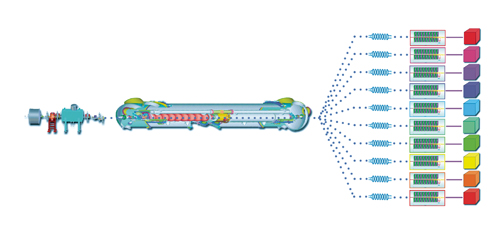
Vision for a future light source at Berkeley Lab: an advanced electron source feeds a two-billion-electron-volt superconducting linear accelerator, whose beam is switched to feed 10 separate free electron lasers, each individually tuned and conditioned to the experimenters' needs.
It’s the kind of prospect the Department of Energy calls a Grand Challenge. To meet it, scientists will need a new generation of light sources, superbright and superfast. Because today’s most advanced synchrotron light sources are fast approaching their ultimate capabilities, achieving higher flux and brightness while slicing time ever more finely will depend on new devices based on superconducting linear accelerators (linacs) and free-electron lasers, or FELs.
“The potential of x-ray FELs for examining ultrafast processes and fine energy structures in chemistry, physics, materials, and biology is being recognized internationally,” says Roger Falcone, Director of the Advanced Light Source (ALS). “At LBNL, we have a world-class group of scientists and engineers who are working to understand the requirements set by grand scientific challenges in these fields.”
The Accelerator and Fusion Research Division (AFRD), the ALS, and the Chemistry, Materials Sciences, and Engineering Divisions have joined together in an Advanced Photon Science Initiative (APSI), whose objectives include assessing the potential for a linac-based FEL light source at Berkeley Lab.
Lab experts “have been honing their skills and developing light source concepts that will give researchers capabilities that exist nowhere else in the world,” notes Steve Gourlay, Director of AFRD. “The next step is an R&D program to turn these ideas into reality.”
“Although the results will be widely applicable, we want to get specific about what would be needed for an actual facility, with a vision of a future FEL facility here at Berkeley Lab,“ says AFRD’s John Corlett, who heads the Advanced Photoinjector Experiment program to develop a high-performance electron injector for new light sources.
FELs work by accelerating bunches of electrons and sending the bunches through arrays of magnets called undulators or wigglers; as the electrons slalom back and forth, they emit photons in the direction of the beam. The electron motion is in phase with the emitted light and the light is all the same phase — thus, a “free electron laser” — quickly building to high intensity.
Corlett names tunability as one advantage of FELs and pulse repetition rate as an important factor affecting performance. “To get the most from an FEL, we also plan to accurately control the lasing process by ‘seeding’ the electron beam with a conventional laser.”
In seeding, a conventional laser fires a beam through an undulator as the electron bunch moves through it. “As they travel together through the undulator, the electric field of the laser pulse manipulates the electrons locally,” Corlett explains. “The field can force the electrons together into tight, high-energy, rapidly repeating micro-bunches.”
The researchers aim to achieve the shortest possible pulses, measured in femtoseconds or even as short as 100 attoseconds. (There are as many femtoseconds in one second as there are seconds in 32 billion years. An attosecond is a thousand times shorter still.)
A FEL can achieve wavelengths in the far ultraviolet and soft x-ray regions by passing the microbunched electron beam through a second undulator, forcing it to emit light at frequencies that are harmonics (multiples) of the original wavelength. A “cascade” of paired undulators allows even higher harmonics to be reached.
Superconducting linacs produce the highest repetition rates and brightnesses. While linacs emit only a single, straight-ahead beam, this beam can be passed through a “switching yard” that transports electron bunches to several FELs. The facility APSI envisages for Berkeley Lab would have 10 or more separate FELs feeding off of one main superconducting linac, each individually configured to meet the experimental needs at that beamline.
This vision for a future light source would turn Berkeley Lab’s hilly setting into an asset, by housing the linac in a tunnel that would pass beneath the ridge on the southern edge of the Lab’s site and re-emerge at the former location of the Bevatron, where an experimental hall for the array of FELs, x-ray beamlines, and experimental end stations would be situated.
The key elements of such a facility would be a high-brightness, high-repetition-rate, low-emittance electron gun (low emittance means, roughly, a tight beam); systems for conditioning and transporting the high-brightness electron bunches produced by the gun; a superconducting linac that would boost the beam to an energy of 2 billion electron volts (2 GeV), followed by distribution in a beam switchyard to 10 or more FELs.
“We have done critical work in all these areas,” Corlett says. “Through the Advanced Photon Science Initiative, Berkeley Lab is ideally suited to perform this research. The Lab has the expertise needed to help advance the field.”
Strategic Path Forward: New Leadership, New Partnerships
Berkeley Lab Director Steve Chu was asked what success will look like during his tenure at the helm of arguably the Office of Science’s premier research facility. “I will consider my time as director of the Lab to be a success,” he said, “if the candidates we want to hire think of the Berkeley Lab as THE place to be.” And here is his evidence:


Yelick, left, and Majumdar are the newest members of the Lab's leadership team
For decades, the “Rad Lab” was at the center of the high energy physics and nuclear chemistry world. It has since branched out into many other areas of physical, biological and mathematical sciences and energy technologies, and during its 76 storied years, Berkeley Lab has had 11 employees who have been awarded Nobel Prizes.
Even more impressive, the Lab has trained over 50 graduate students, post- doctoral fellows and early career scientists who became Nobel Laureates. Similarly, Bell Laboratories and the Medical Research Council’s Laboratory for Molecular Biology in Cambridge, England, were worldwide intellectual magnets during golden eras that spanned more than half a century.
“What did these scientific institutions have in common?” Chu asked. “Fellow scientists collectively set a high standard of excellence. These scientists found the time to find out what was happening in different parts of the organization. Critical to this culture was that informal exchanges of information occurred during lunch time, teas and social events where young scientists could ‘talk science’ with eminent senior scientists.
“Individual genius was nurtured,” he continued, “but individuals were also encouraged to quickly form teams to rapidly exploit new ideas and breakthroughs. The scientific direction was guided by collective wisdom and ‘managed’ by top scientists with intimate, expert knowledge. Many of the very best scientists became managers because they were given resources that allowed them to foster the advancement of science far beyond the reach of an individual research group. Bold approaches were encouraged in a culture where incremental advances were left to lesser institutions and researchers. Some failure was expected, but there was an emphasis on recognizing failure quickly, and moving on to other opportunities.”
In this period of Berkeley Lab’s eighth decade when new programs are burgeoning, unprecedented construction looms, and a new set of scientific and operational leaders are in place, the Director is going back to the future. He is applying fundamental tools of success – grand visions, dynamic leadership, and leveraged partnerships – to seize the moment and, as he euphemistically puts it, “save the world” by returning to the vision for the Lab that founder Ernest Lawrence had.
As he told the Laboratory Advisory Board – the blue-ribbon panel of national experts who report to the University of California President on Lab challenges, issues and progress – at its November meeting, over the next 10 years it will be crucial that:
- The Lab bring together its combined resources in basic sciences to address a variety of problems – or the same problem in different ways – that cut across divisions and funding structures;
- Take full advantage of its ability to tackle scientific problems of scale (in size, time and number of disciplines) that are difficult to capture in University research;
- Create an atmosphere of mutual trust and increased cooperation between the UC Berkeley campus and the Lab, with other national labs, and with DOE headquarters.
The “problems of scale” that Berkeley Lab is well positioned to attack form an impressive and growing list — transformative, carbon-neutral sources of energy; deployable devices and systems that will dramatically decrease the use of fossil fuel energy; a “next generation” light source to open up new scientific frontiers; a deeper understanding of the origin and fate of the universe (what is “dark energy,” “dark matter” and the origin of mass?); energy-efficient and data-intensive high-performance computing; integrative biology (genomics, proteomics, cell signaling and multi-scale imaging); and environmental modeling and measurement. That’s a full plate for any intellectual enterprise.
The effort will take facilities, and it will take leadership, and Chu believes he has the roadmap in place to make things happen. Over the next seven years, according to Jim Krupnick, Director of the Office of Institutional Assurance, 13 construction and seismic upgrade projects of $1 million and above will proceed, dominated by major buildings for energy research (“Helios”), computing (“CRT – Computational Research and Theory”) and Advanced Light Source user support. Five new project managers have been hired to keep it all on time and under budget.
Chu entitled his October off-site management planning meeting “Coping with Success,” a variation on the old saying: “Be careful what you wish for…” He closed the retreat – his third as Director – by stating, “I’m thrilled with the things I’ve seen. We’re off to a great start, but we are not there yet and we can’t get complacent.”
One of the things that reassures him when considering the challenges is the new team of senior leaders that has signed up over the past two years. Most recent were three division directors who, not coincidentally, are also faculty members at UC Berkeley – Don DePaolo for Earth Sciences, Arun Majumdar for Environmental Energy Technologies, and Kathy Yelick for the National Energy Research Scientific Computing Center (NERSC). All are distinguished academicians dedicated to strengthening the partnerships between campus and lab.
No less distinguished in their professional fields are the three women who have taken over programs in Operations – Rosio Alvarez in Information Technologies, Vera Potapenko in Human Resources, and Jennifer Ridgeway in Facilities. Add to this the earlier placements of Jeffrey Fernandez as Chief Financial Officer, Howard Hatayama as EH&S Director, Sandy Merola as Deputy Operations Officer, and Krupnick as institutional assessment officer, and you have a potent stew of talent that Chief Operations Officer David McGraw deemed “a strong bench.” “The most important decision for a manager is in hiring – it starts with the right people,” McGraw told the advisory board. And Chu said, “Great people hire people who are better than they are.”
To hear those new people talk about their own visions is to anticipate a bright future. For example:
Majumdar: “We want to be a global innovation hub in energy efficiency and the environment.”
Yelick: “We (NERSC) will accelerate scientific discovery while leading the field in ultra-efficient low-power technology, scalable data analysis and tools specialization. Modeling and simulation will be on the exascale” (a thousand times more than petascale).
DePaolo: “ESD (Earth Sciences) is centrally positioned between climate change and water resources, so can these be gathered (in combination with other lab programs) into a new Institute for Energy, Climate and Environmental Technologies?”
Potapenko: “Our goal is to help the Lab acquire great talent to complete the Lab’s mission, paying special attention to how we do workforce planning, recruitment and talent management, and career development.”
Ridgeway: “The goal is to become a respected project-based organization that supports the science, meeting the challenges of (insufficient) space, seismic requirements, modernization needs, and cost-effective efficiency.”
Underlying all of these themes, in both operations and scientific advancement, are the essential partnerships between the Berkeley campus and its neighbor up the hill. “We need to build a new culture of mutual trust and respect,” Chu told his division directors.
The (Other) Bird Man of Alcatraz
Take a boat trip out to Alcatraz during the spring and summer months, prime nesting season for seabirds, and you’re likely to find an embarrassment of riches — dark-winged Western Gulls, deep-diving Brandt’s Cormorants, California Gulls, snowy egrets, black-crowned night herons, pelicans and even the occasional hummingbird.
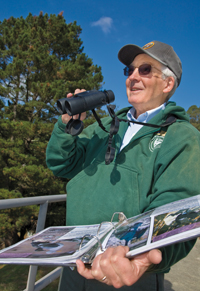
Robinson
You also just might run into 19-year Lab veteran and recent retiree Art Robinson, a National Park Service seabird docent, who volunteers his time on the island answering visitors’ avian questions, inviting them to look through his scope, and, in the off-season, serving as a census taker for bird populations.
So how does a mild-mannered communications specialist for the Advanced Light Source wind up on the Rock? Robinson says it all began with his inauguration into the bird-watching brethren about four years ago. Always an avid hiker, he had begun to find himself taking particular notice of the birds along his path.
“There was this mysterious yellow bird in the marshy area of Muir Beach. I searched the bird books to find out what it was. Though I never did ID it for sure, that was probably when the switch from hiker to birder began. Not long after that, in the same area, I watched a hovering white-tailed kite scan the ground below for prey and then dive down to snatch it. That cinched the deal, and I’ve come across to join the flock, as it were.”
Late last winter, Robinson received an email inviting all interested birders to come to an orientation session about volunteering for the National Park Service as a seabird docent on Alcatraz during the upcoming nesting season. “It was hard to imagine folks knowing less about birds than I did, but I signed up anyway. It has been a marvelous experience.”
Although Robinson acknowledges most visitors to the Rock are there to see the infamous prison, he says many do appreciate the birds as well. “It’s always a thrill to see someone get interested in what they’re seeing. I suppose anyone in a teaching position feels that way. And the teaching works both ways; I’ve met folks from all over the world and heard about the places they come from and about their own indigenous birds.”
Nestled inside the Golden Gate, Alcatraz might not seem to be a natural nesting site for some of the species that settle there. Robinson says they would normally nest on rocky islands, such as the Farallons, where they are free from predators. But Alcatraz is predator-free as well, and thus provides a unique opportunity to observe a phase of seabird life that is normally off limits to all but avian biologists. Robinson is grateful for the opportunity, and effusive about what birding has taught him.
“Birding helps to develop some useful skills,” he says, “like patience — sometimes the best way to see birds is just to be still and let them come to you; and paying attention — a flitting motion in tree leaves may be the only hint that a bird is near; and careful observation — details like the shape of a head may be the main visible distinction between two species that otherwise look alike.
“These skills benefit us in our everyday lives, and they teach us about the interdependence of the natural world. If you want to observe shore birds, for example, there better be marshy and shoreline areas well stocked with the food shore birds need to survive. Birding helps me to see, in a more personal way, why environmental issues are so important.”
Winners Agree: Runaround is ‘An Inspiring Event’
Despite the threat of rain, Berkeley Lab’s 30th annual Runaround got off to a rousing start Oct. 19, with hundreds of participants running, walking and biking the course on a blustery Fall afternoon. About 12 minutes after it began, two seasoned racers had taken top honors in the men’s and women’s categories.
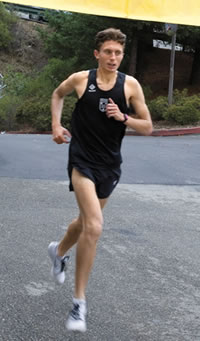
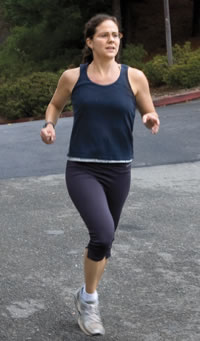
Whitelam (left) was the Mens winner, while Bascom (right) was Womens winner.
Steve Whitelam, a chemist in Phillip Geissler’s soft condensed matter group, was the top men’s finisher in the race. Whitelam finished the 3-kilometer course in 9:26, winning on his second year of running the course. Men’s four-time winner Dula Parkinson (9:50) was the only other runner to finish under 10 minutes.
The top female in the race was Jamie Bascom, a postdoc in Mina Bissell’s cancer research program in Life Sciences, who finished with a time of 12:24, just ahead of Caroline Ajo-Franklin (13:16), a scientist at the Molecular Foundry, and Becka Jones (13:26), a graduate researcher in Eugene Haller’s materials group and last year’s winner.
For Bascom, a three-time Runaround winner (’99, ’01, ’04 ), it was a triumphant return to running after taking a few years hiatus to have a baby. Her son is now 21 months old.
Bascom has been running since the third grade, continuing to run cross-country and track in high school, then at UC Berkeley. But things are a little different for her now. “Before I had my son I ran more miles per week, I did long hilly runs, and occasionally I did speed work. These days I am elated to be able to sneak out for a 30- minute jog around my neighborhood 3-5 times per week.”
Men’s winner Steve Whitelam has now moved to the UK, taking a position at the University of Warwick. He, too, has been running since he was a kid, never to a high level, but for enjoyment, he says.
“The Bay Area is a beautiful place to run, and I’ve been fortunate to take part in a few local races. I admire the participatory spirit here, and the idea of staging competitions on scenic courses at times of day conducive to running. When I grew up in Scotland the prevailing wisdom held that it wasn't a real race unless the conditions were so inclement that only two or three people could finish!”
Both winners praised the spirit of the Lab’s annual event. “The Runaround allows everyone at the lab to get a glimpse of their lab mates or co-workers with a different hat on,” says Bascom. “We can all take 8 minutes or an hour, once a year, to step outside together, breathe some fresh air and take a jog...or an all-out sprint together.”
Whitelam agreed. “I was impressed with the size of the turnout, and people's determination to get round some pretty tough hills. It's an inspiring event.”
And the competition next year? Well, Whitelam won’t be present for the race, but Bascom says she fully intends to run again, “As long as my knees hang in there.”
Berkeley Lab View
Published once a month by the Communications Department for the employees and retirees of Berkeley Lab.
Reid Edwards, Public Affairs Department head
Ron Kolb, Communications Department head
EDITOR
Pamela Patterson, 486-4045, pjpatterson@lbl.gov
Associate editor
Lyn Hunter, 486-4698, lhunter@lbl.gov
STAFF WRITERS
Dan Krotz, 486-4019
Paul Preuss, 486-6249
Lynn Yarris, 486-5375
CONTRIBUTING WRITERS
Ucilia Wang, 495-2402
Allan Chen, 486-4210
David Gilbert, (925) 296-5643
DESIGN
Caitlin Youngquist, 486-4020
Creative Services Office
Berkeley Lab
Communications Department
MS 65, One Cyclotron Road, Berkeley CA 94720
(510) 486-5771
Fax: (510) 486-6641
Berkeley Lab is managed by the University of California for the U.S. Department of Energy.
Online Version
The full text and photographs of each edition of The View, as well as the Currents archive going back to 1994, are published online on the Berkeley Lab website under “Publications” in the A-Z Index. The site allows users to do searches of past articles.
Flea Market is now online at www.lbl.gov/fleamarket
Exploding Hydrogen Molecules Yield World’s Smallest Double-Slit Experiment
“One of the most powerful ways to explore the quantum world is the double-slit experiment,” says Ali Belkacem of Berkeley Lab’s Chemical Sciences Division (CSD). Belkacem is a leader in a University of Frankfurt, Kansas State University, and Auburn University collaboration that recently performed the world’s smallest double-slit experiment at the Advanced Light Source, using as “slits” the two proton nuclei of a hydrogen molecule.
Their results demonstrate that quantum particles start behaving in a classical way on a scale as small as a single hydrogen molecule.
 When an x-ray photon ejects both of a hydrogen molecule's electrons, the two proton nuclei act as slits, causing scattered electron waves to produce interference patterns. The waveform of the fast electron is shown in the image on the right.
When an x-ray photon ejects both of a hydrogen molecule's electrons, the two proton nuclei act as slits, causing scattered electron waves to produce interference patterns. The waveform of the fast electron is shown in the image on the right.
The classical double-slit experiment shines light from a single source through two slits onto a screen. If both slits are open, the beams overlap to form interference fringes, just as waves in water do. If just one is open, the light forms a bright bar, striking the screen like a stream of solid particles. Is light particles or waves? It’s both.
Moreover, particles like electrons also have a wave nature, which is what makes the hydrogen-molecule double-slit experiment possible, explains CSD’s Thorsten Weber, another of the collaboration’s leading researchers. A single x-ray photon hits only one of the molecule’s electrons, “but because they cohere in the quantum sense, the electron that’s hit flies off in one direction with a certain momentum, and the other electron also flies off at a specific angle to it, with a different momentum.”
Considered as particles, the electrons’ angles depend on their energy and how they scatter from the nuclei. Considered as waves, they make interference patterns, revealed by calculating the probability they’ll be found at a given position.
In a tell-tale sign of quantum-mechanical behavior, a single electron can interfere with itself. The ALS experiments at first showed only the self-interference patterns of the fast electrons, with little action from the slow electrons. “But what if we make the slow electron a little more active?” asks Weber. “What if we turn it into an ‘observer?’”
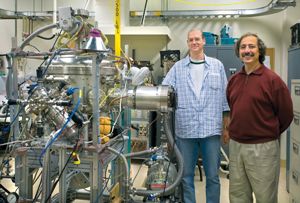
Weber and Belkacem
Quantum systems remain in a state of multiple possibilities until they are measured and forced to choose, amounting to an intrusion by an observer from the big world of classical physics. Increasing the energy of the slow electron turns it into an “observer” of the fast one; the fast electron now interacts with the wider world, of which the slow electron has become a stand-in, and begins to decohere. The self-interference pattern of the fast electron disappears. The system has entered the realm of classical physics.
Both electrons retain their wave nature, however, although their wave patterns cancel each other. These can be reconstructed, in what Belkacem calls “the meat of the experiment”: “Even when the interference pattern has disappeared, we can see that coherence is still there, hidden in the entanglement between the two electrons.”
For those trying to build quantum computers, says Belkacem, “The bad news is that decoherence and loss of information occur on the very tiny scale of a single hydrogen molecule. The good news is that, theoretically, the information isn’t necessarily lost — or at least not completely.”
Understanding RAD51AP1, a Critical Cog in the DNA Repair Machinery
DNA double-strand breaks occur about 10 times in every cell division; the need for accurate repair is constant. In eukaryotes (including humans), RAD51 is the protein that repairs double-strand breaks, through a process known as homologous recombination. RAD51 can’t do the job by itself; a score of other proteins cooperate, and learning how these function is a field of intense study.
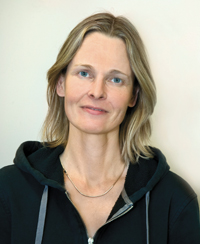
Wiese
“We didn’t know it when we started, but RAD51AP1 is extremely important to this process,” says David Schild of Berkeley Lab’s Life Sciences Division (LSD), who has long studied RAD51 and its associated proteins. (AP stands for Associated Protein.)
Claudia Wiese of Schild’s laboratory led a team investigating RAD51AP1 in cultures of human cancer cells. Eloïse Dray, in Patrick Sung’s lab in the Department of Molecular Biophysics and Biochem-istry at Yale University, led in vitro studies. The collaboration was part of the Structural Cell Biology of DNA Repair Machines project, sponsored by the National Cancer Institute and headed by Berkeley Lab’s John Tainer and Priscilla Cooper.
In homologous recombination, a double-strand break is processed to leave dangling ends on the broken strands. RAD51 proteins wind around one of these long single strands to form a “presynaptic filament,” which seeks out and fastens to a matching intact stretch of DNA on the sister chromosome. The RAD51 protein complex pries up one of the intact sister strands, opening the DNA to form a D-shaped loop, whereupon the broken strands synthesize replacement DNA for themselves by using the exposed, unbroken sister strands as templates.
Schild, Wiese, and their colleagues discovered that RAD51AP1 was more vital to this process than suspected. Cells with depleted levels of RAD51AP1 were extra sensitive to toxins that stress the genome. Double-strand breaks increased, and the cells’ efforts to repair them went awry, resulting in mismatches of the broken ends.
The researchers found that RAD51AP1, unlike other RAD51-complex proteins, works after the formation of the presynaptic filament. They suspect RAD51AP1 helps find the matching sequences needed as templates for repair and enhances RAD51’s ability to form the D-loop, opening the chromosome and exposing the template sequences.
“Our findings are important in two ways,” says Wiese. “They help us better understand how homologous recombination can fail and result in mutations that can lead to cancer. Second, by understanding the role of RAD51AP1 in homologous recombination, we may be able to exploit this knowledge for new kinds of cancer therapy.”
"Promotion of Homologous Recombination and Genomic Stability by RAD51AP1 via RAD51 Recombinase Enhancement," by Claudia Wiese, Eloise Dray, Torsten Groesser, Joseph San Filippo, Idina Shi, David W. Collins, Miaw-Sheue Tsai, Gareth Williams, Bjorn Rydberg, Patrick Sung, and David Schild, appears in the 9 November, 2007 issue of Molecular Cell and is available online to subscribers at http://dx.doi.org/10.1016/j.molcel.2007.08.027.
It’s Official: Berkeley Lab Ground Zero for Biofuels Research
With the signing this week of the contract to launch the $500 million Energy Biosciences Institute (EBI) and the announcement a few weeks ago that the $135 million Department of Energy Joint BioEnergy Institute (JBEI) will make its home in Emeryville, Berkeley Lab — common partner in both and institutional leader of JBEI — can officially call itself the nation’s nexus for innovative research on biofuels.
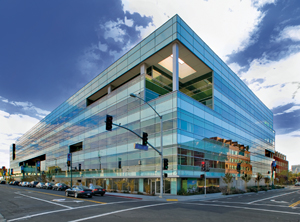
Pursuing different yet complementary goals, the two research centers will soon embark on a journey into the realm of alternative energy unlike any that has been attempted before. Dreams of carbon-free replacements for oil and gas take a step closer to reality when nearly 40 projects get funding from EBI later this month, while on Potter Street in Berkeley and at Sandia-Livermore, bioscientists start to crack the code for the efficient production of fuels from lignocellulosic material in plants.
EBI’s charge is much broader. Funded by the British energy conglomerate BP, the institute features Berkeley Lab, the UC Berkeley campus, and University of Illinois Urbana-Champaign working with industry on the fundamental science that underpins the whole field of biofuels. This exploratory “think tank” approach will include investigations into feedstocks, catalysts to convert biomass to sugars, microorganisms that ferment sugars, plus the social, economic and environmental implications of this new industry.
Campus workers are refurbishing space in Calvin and Hildebrand laboratories for occupation by EBI in early 2008. This temporary headquarters will shift to a permanent home up the hill, on the border between campus and Lab next to the Molecular Foundry, when the Helios building is completed in 2010. The balance of the 10-year project will proceed there and in Illinois, where the majority of plant growth and testing will take place.
Across town, at 5885 Hollis St. in Emeryville (above), JBEI will be setting up permanent shop next spring in new quarters at EmeryStation East. A media introduction to the space in October revealed extensive fourth-floor areas for laboratories and offices, all at an accessible center for six institute partners — Berkeley Lab, UC Berkeley, Sandia, Livermore Lab, UC Davis and the Carnegie Institute for the Sciences.
This start-up style research institute has one primary goal — using genomics, systems biology and the application of science and technology to enable cost-effective production of cellulosic ethanol and other biofuels. The search for renewable, carbon-neutral energy has been funded at three national centers by the Department of Energy with five-year grants.
The Directors of EBI and JBEI are both prominent physical bioscientists at Berkeley Lab. Chris Somerville, recently added to the UC Berkeley faculty from his prior assignment at Stanford, takes over the BP project as one of the world’s leading authorities on conversion of plant cellulose to energy. JBEI is headed by Jay Keasling, Discover Magazine’s 2006 “Scientist of the Year” and synthetic biology pioneer.
The EBI contract has both an “open” and “proprietary” component of its research. All university-led research results will be published, and intellectual property owned, by the university. BP will maintain its own private leased lab space and will retain inventions by its personnel. Decisions on what research to fund will be recommended to a governing board by an executive committee predominantly comprised of university and Lab scientists. The first slate of research projects to be funded will be announced later this month.
The entire contract is posted on the EBI web site (www.energybio-sciencesinstitute.org)
NERSC Puts One of World’s 10 Most Powerful Supercomputers into Operation
After several months of rigorous testing, DOE’s National Energy Research Scientific Computing Center (NERSC) accepted a 20,000-processor Cray XT4 supercomputer, providing NERSC users with a system offering a top processing speed of more than 101 teraflops, or 101 trillion calculations per second. When the newest list of the world’s Top 500 supercomputers was released Nov. 12, the system was ranked No. 9 overall.
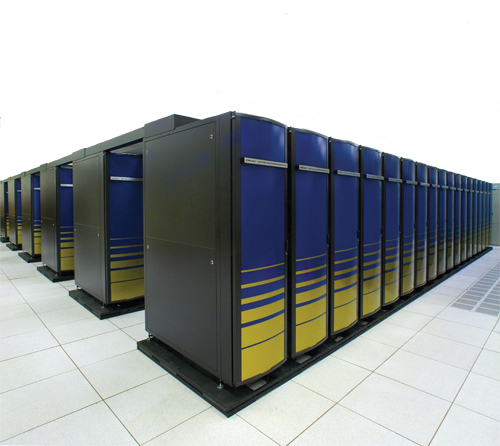
The next-generation supercomputer, named “Franklin” in honor of the first internationally recognized American scientist, Benjamin Franklin, will be used to run applications across a wide range of scientific disciplines, including astrophysics, fusion, climate change prediction, combustion, energy and biology. The powerful system will also allow researchers to explore clean energy technologies and validate theories that attempt to uncover evidence that explains the origin of the universe.
“Our new Cray XT4 system has demonstrated that it can deliver a high sustained performance on a demanding scientific workload in a rigorous production environment while at the same time permitting users to explore scaling to 20,000 cores,” said NERSC Division Director Horst Simon.
During negotiations to procure the system, NERSC and Cray mapped out a plan to install the Cray Linux Environment (CLE) on each of Franklin’s 9,672 nodes. As a result of this partnership, NERSC became the first center with a production XT4 running CLE, an ultra-lightweight version of the standard Linux operating system. CLE makes the system easier to use, allowing users to more easily port their scientific applications from other architectures. During extensive testing, about 300 different features and functions were tested and validated, making CLE more reliable with the same or better performance than previous XT operating systems, according to NERSC General Manager Bill Kramer .
“With Franklin, we are increasing the computational power available to our 2,900 NERSC users by a factor of six, providing them with access to one of the world’s fastest supercomputers dedicated to open scientific research,” said Michael Strayer, associate director of DOE’s Office of Advanced Scientific Computing Research, which funds NERSC. “We have high expectations that NERSC’s proven track record of scientific productivity will provide many new discoveries and understandings.”
As part of an extensive testing program, a number of NERSC users were given early access to Franklin to ensure that the system could handle the most demanding scientific applications.
Ar project led by Julian Borrill of Berkeley Lab leveraged Franklin’s computing power to prepare for analyzing the massive amounts of data to be sent back to Earth by the Planck satellite set for launch in 2008. A joint U.S.-European project, Planck will use 74 detectors to measure cosmic microwave background, the residual radiation from the actual “Big Bang.” Last scattered some 400,000 years after the Big Bang, it provides the earliest possible image of the universe, including encoded signatures of the fundamental parameters of all matter.
“I am delighted to report that we have just successfully created a map of the entire Planck Full Focal Plane one-year simulation,” Borrill said. “This is the first time that so many data samples—three terabytes of data in 50,000 files, representing all the information collected by Planck during one mission year — have been analyzed simultaneously, a primary goal of our group’s early Franklin efforts.”
Franklin contains 9,672 AMD dual-core Opteron 2.6 GHz processors with 39 terabytes of memory. Running on 16,384 processor cores, Borrill’s team was able to complete the run in just 45 minutes.
Mom’s Duties Begin Very, Very Early
A mother’s work is never done, but who knew it started this early? Long before mom applies band-aids to scraped knees, she’s tasked with repairing DNA breaks in the fertilized egg that were passed on by dad. Now, Berkeley Lab scientists have pinpointed the genes that regulate this first foray into motherly care.
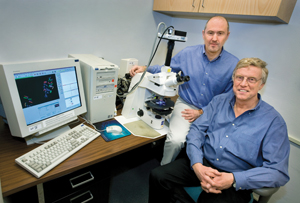
Marchetti (left) and Wyrobek next to a fluorescence microscope and a computer rendition of a mouse zygote used in their research.
“We’ve identified the maternal genes responsible for repairing DNA damage in the fertilized egg that were transmitted by sperm,” says Francesco Marchetti of the Life Sciences Division.
This urgent bit of maternal DNA repair, which in humans occurs during the first several cell-division cycles after fertilization, is critical to preventing chromosomal problems in the fertilized egg, also called a zygote, which can lead to pregnancy loss, infant mortality, birth defects, and genetic diseases in offspring. Scientists have long known that the maternal genotype is equipped to fix double-strand breaks in the DNA donated by dad. But they didn’t know which genes regulate this all-important work.
To explore this question, Marchetti and fellow Life Sciences Division senior scientist Andy Wyrobek, working with scientists from the Netherlands, turned to mice. First, they exposed male mice to ionizing radiation, which induces double-strand breaks in the DNA in their developing sperm. During the final two weeks of sperm development in mice — and during the final three weeks in humans — DNA within sperm lacks the ability to repair itself.
“This means that damage that is sustained during this window is most likely transmitted to the egg, and then it’s up to the egg to repair it,” says Wyrobek.
Seven days after irradiating the male mice, the scientists mated them with three types of female mice. One type of mouse lacked a gene called scid, which repairs DNA double-strand breaks. Another mouse lacked a gene called Rad54, which ensures that the genetic information in the damaged DNA remains intact. A third type of mouse was normal and had both genes, and was used as a control. What they found surprised them.
“When we removed the scid gene, which is the gene needed to repair double-strand breaks, the frequency of zygotes with chromosomal aberrations doubled,” says Marchetti.
In addition, female mice missing the Rad54 missing gene also had an increase in aberrations in their fertilized eggs, but these were confined to a smaller subset of genetic problems. Overall, the scid gene played the largest role in fixing dad’s DNA.
“The ability to repair DNA double-strand breaks is critical to fixing the damage introduced by sperm, and for the first time we’ve linked this repair mechanism to a specific gene,” says Wyrobek. “This means that if an egg that is able to repair double-strand breaks in DNA, then it can repair the damage transmitted by sperm. But take away this mechanism, and 50 percent of this damage gets through, which increases the risk of pregnancy loss or of a child being born with a chromosomal defect.”
Although their work focused on mom’s handiwork in cleaning up dad’s DNA, it doesn’t let dad off the hook. According to Marchetti, there are steps that dads can take to ensure that mom doesn’t have to work overtime to repair his DNA. Chief among them is to stop smoking, which is known to cause DNA lesions.
Their research may also help in vitro fertilization efforts, which currently focuses on ensuring that an embryo develops in an optimum environment. Now, it’s clear that the genetic health of the zygote during its earliest stages is as important as a developing embryo’s surroundings.
Their research was published Oct. 31 in the online early edition of the Proceedings of the National Academy of Sciences. The data collection phase of their work was conducted while Marchetti and Wyrobek were at Lawrence Livermore National Lab. The data analysis phase of the research was conducted after the scientists moved to Berkeley Lab.
Genomics Scientist Wins Presidential Early Career Award
Genomics researcher Len Pennacchio had a lot of people to thank earlier this month as he flew to Washington D.C. to receive the Presidential Early Career Award for Scientists and Engineers (PECASE), which honors the achievements of young professionals beginning their independent research careers in science and technology.
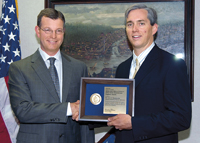
Pennacchio (left) with Deputy Secretary of Energy Clay Sell
Topping the list are his parents. His dad emigrated from Italy via Ellis Island. His mom emigrated from Finland. They came to the U.S. seeking a better life. Although both only had high school diplomas, they firmly believed in the importance of education.
“My parents’ support provided the environment that enabled me to get to where I am today,” says Pennacchio, who is a senior staff scientist in Berkeley Lab’s Genomics Division and head of the Joint Genome Institute’s genome analysis program.
There’s also the long list of people who helped him along during his academic and scientific career. He credits his teachers in the California public school system, his undergraduate experience at Sonoma State University, and the scientific training he received from Rick Myers at Stanford University, where he received his Ph.D., and from Eddy Rubin at Berkeley Lab, where he’s worked for the past eight years.
“I’m honored to receive this prestigious award, and also see this as an opportunity to acknowledge my past mentors,” he says.
Pennacchio and other PECASE recipients were honored in an award ceremony in the nation’s capitol on Nov. 1. He received a citation from the President and $50,000 per year for five years to support his research. He was recognized for his contributions to the generation and interpretation of the human genome sequence.
Specifically, he assigned gene regulatory function to the human genome through the coupling of vertebrate comparative genomics and large-scale studies in mice, using a world-class mouse resource that he developed. Ever the scientist, he attributes his success to a mix of nature and nurture.
“In human biology, most traits are an interplay between environment and heredity,” he says. “This also applies me. I got to where I am today thanks to some natural ability and the right childhood and schooling environment.”
So what’s next for Pennacchio? More of the kind of research that earned him the award, which means using mouse models to understand how DNA sequence variation contributes to trait differences within a species. “I’m excited about my career in science. This award provides some financial support for the next five years, but it doesn’t change my path forward.”
Pennacchio follows in the footsteps of other Berkeley Lab PECASE winners, including Molecular Foundry Director Carolyn Bertozzi and Life Sciences Division researchers Abby Dernburg and Michael Eisen.
Berkeley Lab Science Roundup

A single nanotube, tuned to a selected frequency, vibrates in response to a radio signal and is amplified by outside circuitry. The nanotube radio is small enough to fit into a human cell.
Calling All Car ... bon Nanotubes
Alex Zettl, of the Materials Sciences Division and UC Berkeley’s Department of Physics, and members of his lab including Kenneth Jensen, Jeffrey Weldon, and Henry Garcia, have made a fully functional radio from a single carbon nanotube, orders of magnitude smaller than any radio ever made before. Although it has the same essential components as a conventional radio — antenna, tunable band-pass filter, amplifier, and demodulator — the nanotube radio works only partly as an electrical device; it is also partly mechanical. A battery or other outside power source charges the nanotube. The nanotube acts as an antenna and vibrates when the frequency of incoming radio waves resonates with its mechanical bending frequency, which can be adjusted. The vibrating charged tip modulates a current supplied by the outside power source, generating a signal which can be amplified. Since the nanostructures essentially assemble themselves, are easily tuned to the desired frequency, and can fit inside a human cell, Zettl believes they will be easy to mass produce, with applications ranging from invisible cell phones and hearing aids to radio-controlled devices in the brain, muscles, and bloodstream. The group’s report appeared online Oct. 31 in Nano Letters.
Clicking on a Link
Introduced in 2001, a copper-catalyzed azide-alkyne reaction that swiftly “clicks” chemical building blocks together has been valuable for attaching molecular probes to molecules in test tubes and on fixed cells. Unfortunately the copper catalyst is toxic to living cells. Now Carolyn Bertozzi, of the Materials Sciences Division (MSD) and UC Berkeley’s Department of Chemistry, and colleagues including Jeremy Baskin and Isaac Miller of the Physical Biosciences Division and Scott Laughlin of MSD, have developed a copper-free version of the reaction that happens just as fast with no apparent toxicity. The researchers are already using the copper-free click chemistry to probe polymer sugars in living cells and in live zebrafish embryos. Their report appeared Oct. 17 in Proceedings of the National Academy of Science.
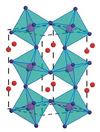
Berkeley Lab researchers and their colleagues distorted a manganite crystal in such a way as to change its electrical properties, by selectively exciting a single vibrational mode with a blast of terahertz radiation.
Good Vibrations
In a new study of coupling between crystal structure and the conduction properties of strongly correlated electrons, Matteo Rini of the Materials Sciences Division and his MSD colleagues Jiro Itatani and Robert Schoenlein, with collaborators in England and Japan, have used ultrafast pulses of terahertz radiation to trigger molecular vibrations that instantly change a manganite crystal from an electrical insulator to a conductor. Today’s electronics industry is mostly based on weakly correlated semiconductors, but the terahertz technique opens a wider range of new technological possibilities. Even a subtle alteration of electronic activity in a strongly correlated material can have an enormous impact on its electrical and magnetic properties. The work appeared in the Sept. 6 Nature.

Clockwise from bottom: the flagella of these swimming green algae, "Chlamies," are oriented early and midway in their strokes, then recovering, turning, and swimming backwards.
Tiny Green Time Capsule
“Chlamy” is what scientists call green alga of the genus Chlamydomonas, whose photosynthetic machinery harks back to the ancestors of chloroplasts, the light-capturing, energy-converting, oxygen-producing organelles of plants. Daniel Rokhsar and Simon Prochnik of DOE’s Joint Genome Institute, along with Arthur Grossman of the Carnegie Institution and Stanford and Sabeeha Merchant of UCLA, recently led a multi-institutional analysis of the Chlamy genome. The results should enable new strategies for solar energy, carbon uptake, soil detoxification, and biofuels. The 100-plus members of the research team published their results in the Oct. 12 Science.
Brightening the Mood
Monoamine oxidases, chemicals that break down neurotransmitters like serotonin and dopamine in the brain, are implicated in mood swings and depression and diseases like Parkinson’s and Alzheimer’s, and may even affect personality. Until now there have been no direct probes for monoamine oxidases in living cells, but Christopher Chang of the Chemical Sciences Division and UCB’s Department of Chemistry, with his colleagues, has developed probes that for the first time seek out monoamine oxidase in cells in vitro, using amine derivatives of the red-fluorescent dye, resorufin, to pinpoint and light up monoamine oxidase activity under the microscope. The results appear in the advance online edition of the Nov. 28 issue of Chemical Communications.
Sequestering Carbon, Way Way Down Under
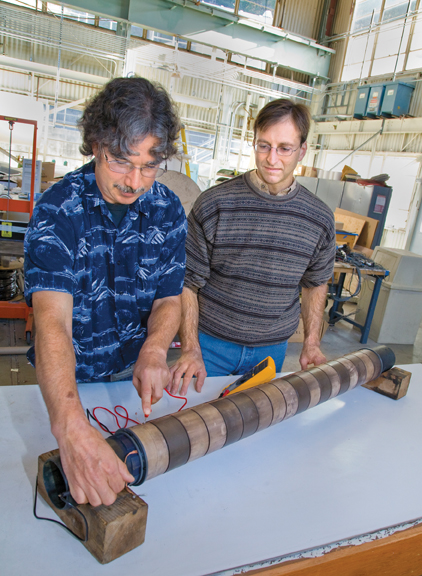

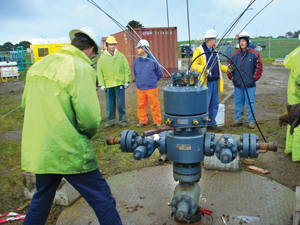
Barry Freifeld (left) and Tom Casey of the Earth Sciences Division recently returned from the Otway Basin near Melbourne, Australia, where they installed Berkeley Lab-built instruments for monitoring movement of CO2 in the world’s first experiment to measure carbon sequestration in a depleted natural gas reservoir. Naturally occurring CO2 is extracted from a low-quality gas well two miles away and reinjected into a test well a mile and a quarter deep. The monitoring equipment was lowered into a parallel well a thousand feet away. The string of instruments was assembled on a 125-foot-long truss, while rain, hail, and wind gusts up to 50 mph plagued the four-day operation. The most delicate work had to be fitted into a last-minute, early-morning break in the foul weather, when the string on its supporting truss was lifted into vertical position by two tall cranes, then handed off to a third crane that slowly lowered it into the narrow well shaft (above) and then connected to instruments (below). The primary agency for the Otway Project is Australia’s CO2CRC (Cooperative Research Center for Greenhouse Gas Technologies).
High Five to Lab’s New AAAS Fellows

Feinberg
Five Berkeley Lab scientists were among the 471 newly selected Fellows of the American Association for the Advancement of Science (AAAS), the world’s largest general scientific society. AAAS Fellows, a tradition that began in 1874, are chosen by their peers for their distinguished contributions to science research, teaching, technology or administration.
The 2007 Fellows elected from Berkeley Lab were Hendrik Bluhm (Chemical Sciences), Ben Feinberg (Advanced Light Source), Judith Klinman (Physical Biosciences), David Patterson (Computational Research), and Randy Schekman, a UC Berkeley professor of molecular and cell biology and guest researcher in the Life Sciences Division.

Klinman
Hendrik Bluhm is a member of CSD’s Glenn T. Seaborg Center, and the local contact for the ALS Molecular Science Beamline. He was elected “for the development of ambient pressure methods of photoemission spectroscopy and the application of synchrotron radiation experiments to liquids and solids at ambient pressures.”
Ben Feinberg, deputy division director for the ALS, was elected “for outstanding contributions to user facilities, especially the Advanced Light Source.”

Patterson
Judith Klinman, a PBD chemist and UC Berkeley professor of chemistry, was elected “for her discovery of protein derived quino-cofactors, demonstration of nuclear tunneling in enzymatic carbon-hydrogen activation, and advances on oxygen activation by enzymes.”
David Patterson, who is also the Pardee Professor of Computer Science at UC Berkeley, was elected “for distinguished contributions to computer architecture and for distinguished leadership of the field.”

Schekman
Randy Schekman was elected “for distinguished contributions to the field of cell biology, particularly for elucidating molecular pathways mediating protein secretion, membrane assembly and vesicle transport by eukaryotic cells.”
The new AAAS Fellows will be presented with an official certificate and a gold and blue (representing science and engineering) rosette pin on Feb. 16, at the Fellows Forum during the AAAS Annual Meeting in Boston.
People, Awards, and Honors



Three Honored for ‘Lab21’ Energy Efficiency Awards
The Laboratories for the 21st Century (Labs21) program has been named one of five recipients of the Presidential Awards for Leadership in Federal Energy Management. Eight individuals have been named, including three from the Environmental Energy Technologies Division (from left): Dale Sartor, Geoffrey Bell, and Paul Mathew. The goal of the combined DOE and EPA Labs21 program is to improve energy efficiency and environmental performance of laboratories in the United States and around the world.

Clean Water System Nets Gadgil UN Award
Ashok Gadgil has received a Global Citizen Award from the United Nations Association (East Bay branch) for his development of a low-cost water purification system. Gadgil is a researcher with Berkeley Lab’s Environmental Energy Technologies Division. He was specifically recognized for his “individual efforts to ensure his invention is in place and functioning, saving lives and improving the quality of life of the beneficiaries.” The association seeks to support the work of the United Nations and the UN Charter.

Geothermal Award For Earth Scientist
Karsten Pruess, with Berkeley Lab’s Earth Sciences Division, received the 2007 Henry J. Ramey Jr. Reservoir Engineering Award in recognition of his achievements in the field of geothermal reservoir engineering. The award was presented by the Geothermal Resources Council. Pruess has significantly contributed to the understanding of fluid flow and heat transfer in fractured geothermal reservoirs and developed the TOUGH suite of nonisothermal multiphase flow simulators for applications in geothermal reservoir engineering.

Materials Scientist Gets Japanese Honor
Chuck Fadley, a physicist with Berkeley Lab’s Materials Sciences Division and UC Davis, was presented with an award from the Japanese Society for the Promotion of Science for his development of characterization methods based on photoelectron spectroscopy and synchrotron radiation, and for his mentoring of young scientists. Fadley is one of the world’s foremost practitioners of photoelectron spectroscopy and a veteran user of the Advanced Light Source.
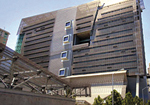
Lab-Designed Efficiency Earns Building Honors
Time magazine has named the San Francisco Federal Building one of its 2007 “Best Inventions of the Year” winners in the architecture category. Its citation noted that the building is “really a machine for delivering sunlight and fresh air to the people who work there. Eighty-five percent of the work space gets natural sun, and windows manned by computer let in outside air to maintain the building’s temperature with a minimum of air-conditioning.” The building’s energy efficiency features were modeled by scientists in Berkeley Lab’s Environmental Energy Technologies Division using EnergyPlus software, led by Philip Haves.
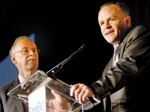
Keasling, Somerville Get BayBio Awards
Berkeley Lab’s Jay Keasling and Chris Somerville received this year’s Visionary Award from BayBio for their roles (respectively) in bringing the Joint BioEnergy Institute (JBEI) and the Energy Biosciences Institute (EBI) to Berkeley. BayBio is a trade association serving the life science industry in Northern California. Each year the group recognizes achievement and honors excellence in the field.

Batteries Expert Joins Electrochemical Society
John Newman, with Berkeley Lab’s Environmental Energy Technologies Division, was made an honorary member of the Electrochemical Society. Newman is the leader of EETD’s Batteries for Advanced Transportation Technologies Program. At the society’s meeting in Washington D.C. earlier this month, Newman also received the Vittorio de Nora Award for contributions to the field of electrochemical engineering and technology.
Retired Lab Physicist Heads Underground Lab
Jose Alonso, a long-time physicist with Berkeley Lab’s Accelerator and Fusion Research Division, has been named the first director of the Sanford Underground Science and Engineering Laboratory (SUSEL). The multipurpose facility is being constructed at Homestake, a former gold mine in South Dakota. Alonso, who retired from the Lab in 2002, was one of the principals behind the Bevelac accelerator configuration. While overseeing its operations, he helped develop technology for applying heavy ion beams to cancer radiotherapy and medical diagnostic imaging. In his final years at the Lab he coordinated accelerator and target elements for the Spallation Neutron Source. Since “retiring,” he’s been active in the Large Hadron Collider project.
In Memoriam
Longtime Lab Administrator Tina Aitkens

Tina (Augustine) Aitkens, who for 26 years served as a staff administrator, supervisor, and human resources generalist at Berkeley Lab, passed away in a nursing home in Fremont on Tuesday after a long illness. She was 60. Aitkens was hired in March, 1977. She worked in several divisions, including the Advanced Light Source, Administrative Services, Accelerator and Fusion Research, and Human Resources. Her roles included Program Administrator for AFRD, supervisor of the ALS User Office, and HR specialist for General Sciences and Operations. A native of Arkansas, she was a very active member of her church. She is survived by her son, Curtis, and one grandson. Services are pending.
Ex-Lab Physicist Stanley Flatté, 66
Physicist Stanley Flatté, whose work on wave propagation led to important contributions in the fields of atmospheric optics, ocean acoustics, and seismology, died last Sunday at his home in Santa Cruz. He was 66. Flatté, a professor emeritus of physics at UC Santa Cruz, worked as a research physicist at Berkeley Lab for five years before joining the Santa Cruz faculty in 1971.
Elizabeth Cawdry Thomas, Wife of Lab Physicist Bob Birge

The wife of retired Berkeley Lab physicist Bob Birge, Elizabeth Cawdry Thomas, will be honored at a memorial service in Berkeley tomorrow. She died Oct. 20 at age 67. She taught cooking in Berkeley for 20 years and was known for her pioneering work in “molecular gastronomy.” Her husband worked at the Lab for many years, including service as director of the Physics Division from 1973 to 1981